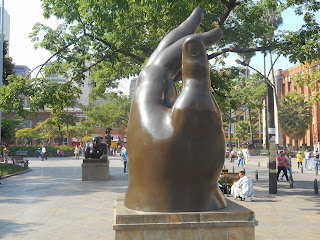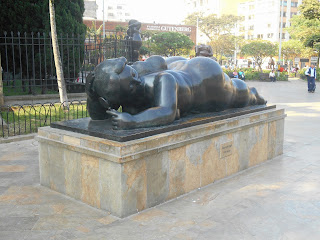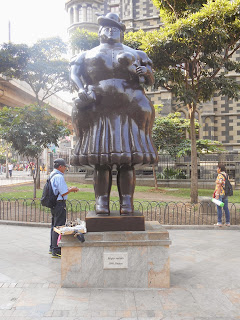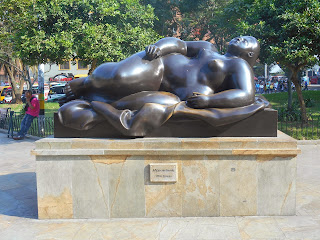Plaza Botero, located in the heart of Medellín, is one of the city's most iconic landmarks. This urban space not only reflects the cultural and artistic richness of the region but has also had a significant impact on Medellín's social and urban transformation over the past few decades. Through its stunning sculptures, the plaza has become a meeting point for both locals and tourists, symbolizing the city's evolution.
In this article, we will explore the history of Plaza Botero, its cultural and social importance, the features of its famous sculptures, and how this space contributes to Medellín's identity as an emerging cultural hub in Latin America.
 |
Plaza Botero - Photography: Leonardo Bernal T. |
History and Origins of Plaza Botero
Plaza Botero is located in Medellín's historic center, an area that has traditionally been the city's political, commercial, and cultural core. The plaza was inaugurated in 2000, though the idea of creating this public space dates back to the late 1990s as part of a broader effort to revitalize the city center and make it more accessible and appealing to both residents and visitors.
The art that defines the plaza was donated by the renowned Colombian sculptor Fernando Botero, who is widely recognized for his depictions of oversized human figures, known as the "Boterismo" style. Botero, born in Medellín in 1932, decided to gift these works to his hometown as a contribution to the city's cultural and urban revival, after having faced significant issues of violence and neglect in previous decades.
The Museo de Antioquia, located on the plaza, also plays a crucial role in solidifying this cultural project, housing an extensive collection of Botero's works alongside other national and international artists. In this way, Plaza Botero is not only a representation of a great artist's work but also an integral part of the larger context of Medellín's cultural and artistic regeneration.
Fernando Botero's Style and His Sculptures in Plaza Botero: A Tour of 23 Monumental Works
Plaza Botero, located in the heart of Medellín, is a tribute to the great Colombian artist Fernando Botero, who donated 23 monumental sculptures to the city. These sculptures have transformed the public space into a cultural, artistic, and tourist center. Known for his unique style, "Boterismo", which features figures with exaggerated proportions and rounded forms, Botero has created works that not only stand out for their size and presence but also invite viewers to reflect on humanity, beauty, and the depiction of the body in art.
Botero's Sculptures in Plaza Botero
The 23 sculptures by Fernando Botero in Plaza Botero are displayed in an open-air space where visitors can interact with the art. Here's the correct list of sculptures you can find in the plaza:
Mujer
A large figure of a woman representing both sensuality and feminine strength in the Boterismo tradition.
 |
| Mujer Photography: Leonardo Bernal T. |
Mujer con Fruta
This sculpture shows a woman holding a fruit, another classic representation by Botero, blending human figures with everyday objects.
 |
| Mujer con fruta Photography: Leonardo Bernal T. |
Gato
One of the most iconic sculptures, El Gato has become a symbol of the city. With its large ears and bulky body, the cat stands out for its size and invites public interaction.
 |
| Gato Photography: Leonardo Bernal T. |
Adán
The figure of Adam, with a robust and exaggerated body, is part of Botero's portrayal of primordial humanity.Eva
Similar to Adam, Eve is the feminine counterpart, with generously voluptuous forms that challenge classical depictions in religious art.
Caballo
The Horse is another monumental piece highlighting Botero's love for animals, represented in his characteristic style with soft, rounded lines.
Mujer con Espejo
In this sculpture, a woman holds a mirror, referencing both feminine beauty and personal introspection.
Mujer Sentada
This seated woman represents serenity and rest, with exaggerated proportions that underscore sensuality in stillness.
Perro
The Dog is a playful and accessible sculpture, with a robust and joyful figure that stands out for its tenderness and dynamism.
Hombre Vestido
The Dressed Man is a portrayal of a robust man, fully clothed, with an upright posture reflecting power and masculine presence.
Mujer Vestida
Similar to the previous one, this figure shows a woman in clothing, with amplified volume conveying a sense of fullness and strength.
Maternidad
One of Botero's most tender works, Maternity captures the bond between mother and child, symbolizing protection and maternal love.
Esfinge
Botero's Sphinx is a mythological figure reinterpreted in his signature style, with an air of mystery and wisdom.
Rapto de Europa
This work references classical mythology, where Europe is abducted by Zeus transformed into a bull. Botero interprets it with his characteristic exaggerated proportions.
 |
| Rapto de Europa Photography: Leonardo Bernal T. |
Hombre a Caballo
Another classical figure, the Rider on Horseback, presents a mounted man, a recurrent theme in equestrian art, interpreted with Botero's distinctive volume.
Mujer Reclinada
In this sculpture, a woman reclines, showcasing relaxation and female voluptuousness in the artist's unique technique.
Hombre Caminante
The Walking Man depicts a human figure in motion, capturing strength and determination as a person advances on their path.
 |
| Hombre caminante Fotografía: Leonardo Bernal T. |
Caballo con Bridas
This sculpture highlights the dynamism of a bridled horse, symbolizing nobility and control while maintaining Botero's monumental style.
Soldado Romano
The Roman Soldier evokes warriors of the Roman Empire, depicted with the powerful presence typical of Botero's figures.
Venus Dormida o Mujer Dormida
This sculpture shows a woman resting, with her exaggeratedly robust figure emphasizing the serenity of sleep.
Cabeza
The Head is an abstract sculpture that emphasizes human features in a simplified yet amplified form, celebrating the human shape in its simplicity.
Pensamiento
A figure that conveys reflection and introspection, Pensamiento captures the essence of the human mind, represented in a robust and solid form.
Mano
Botero's Hand is a sculpture that highlights the importance of this human organ, represented in a giant and detailed manner, prompting reflection on human action.
 |
Mano
|
The Cultural and Social Impact of Plaza Botero
Plaza Botero has had a considerable impact on the social and cultural life of Medellín. For many years, the city's center was marked by violence and neglect, but over the past two decades, Medellín has worked tirelessly to transform its image. Initiatives like the creation of Plaza Botero have been part of a broader effort to revitalize the city center and promote art and culture as tools for social transformation.
One of the most notable effects of Plaza Botero has been its ability to attract both tourists and local residents. Botero's art has given Medellín a new identity internationally, positioning it as a cultural destination worldwide. Furthermore, the plaza serves as a meeting place for the community, hosting cultural events, musical performances, and educational activities that engage the local population.
Medellín, once known for its violence in the 1980s and 1990s, is now seen as a model for urban renewal and social change. Plaza Botero has become a symbol of this transformation. Visitors to the plaza not only experience a lesson in art but also witness a testament to the city's resilience, which has overcome significant challenges to become a cultural and social reference point.
Plaza Botero and its Relationship with the Museo de Antioquia
The Museo de Antioquia is another vital component of Plaza Botero. This museum houses one of the most comprehensive collections of Botero's works, as well as a valuable collection of contemporary and modern art. The museum is a key reference in Medellín's art scene and has played an essential role in positioning the city as a renowned cultural destination.
The relationship between Plaza Botero and the Museo de Antioquia is symbiotic. While the sculptures in the plaza allow for public, free interaction with the art, the museum offers a more in-depth and detailed perspective on the work of Botero and other artists. In fact, the museum not only showcases Botero's works but also hosts temporary exhibitions and a rich collection of art by Colombian and international artists, contributing to the cultural dynamism of the city center.
The museum works hand in hand with the Medellín City Hall to offer educational activities, workshops, and events involving the local community, strengthening the bond between art and the citizens.
Plaza Botero as a Tourist Hub in Medellín
Plaza Botero is one of the most visited places by tourists in Medellín. In addition to its proximity to the Museo de Antioquia, it is close to other tourist attractions such as the Iglesia de la Candelaria, Parque Bolívar, and the Palacio de la Cultura Rafael Uribe Uribe. This makes Plaza Botero a perfect starting point for those wanting to explore Medellín's historic center.
The plaza has also hosted significant cultural events, including music festivals, open-air art exhibitions, and community activities. The plaza's accessibility, combined with the beauty of the sculptures and its surroundings, has made it a landmark in the city's tourist route.
Challenges and Future of Plaza Botero
Despite its undeniable successes, Plaza Botero faces certain challenges. One of the main issues is the preservation of the public space. Due to the high number of visitors, both locals and tourists, there have been some problems related to security, cleanliness, and maintenance of the area. However, Medellín's City Hall has implemented measures to ensure that the plaza remains an attractive and safe space for everyone.
In the future, Plaza Botero is expected to continue evolving as a cultural and social space. Efforts to preserve and promote the works of Fernando Botero, alongside the support of the local community, will ensure that this space remains a symbol of Medellín's cultural identity and its transformation into a thriving metropolis.
Conclusion
Plaza Botero is more than just a space filled with sculptures. It is a symbol of the transformation that Medellín has undergone over the years. Through Botero's monumental art, the city has not only created a significant cultural destination but also a meeting place where the local population can gather, reflect, and interact with the art. As a symbol of Medellín's resilience, Plaza Botero has become an essential part of the city's identity, representing the fusion of tradition, art, and urban development.
Sources:
- Plaza Botero - Museo de Antioquia: Una fuente oficial que ofrece detalles sobre las esculturas y su conexión con el Museo de Antioquia. Museo de Antioquia
- Visit Medellín - Página oficial de turismo: Información sobre los puntos turísticos, incluyendo la Plaza Botero. Visit Medellín
- Fernando Botero - Fundación Botero: Una visión general de la vida y obra de Botero, con un enfoque en su estilo y su legado artístico. Fundación Botero
- El Tiempo - La Plaza Botero: Un símbolo de Medellín: Artículo sobre la historia y el significado cultural de la Plaza Botero. El Tiempo
















No hay comentarios:
Publicar un comentario